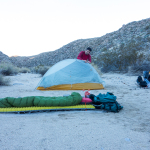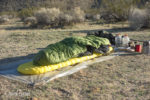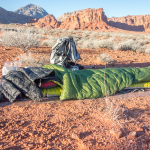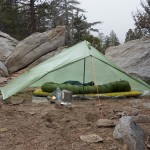
I bought this sleeping bag in 2012. Since then, it is the sleeping bag I have brought with me for over 50% of my backpacking trips.
Today I have two sleeping bags and one quilt that I use for backpacking. All are over 10 years old. Which one I bring is decided by the environmental conditions (temperature) I expect. Temperature is the only determining factor.
The Zpack sleeping bag does what I need to do, with the caveat that is does have some limitations and faults. So let’s delve into this piece of gear.
Sleeping Bag Temperature Ratings
The Zpack sleeping bag is rated by the manufacturer at 20° F. Generally we can ignore manufacturers ratings as they are usually just marketing hype. Western Mountaineering does have accurate ratings (and sometimes they are conservative).
Before going further, you may want to read my article on down insulation, and my review of the Western Mountaineering UltraLite 20° F sleeping bag.
Western Mountaineering UltraLite Sleeping Bag —15 Year Review
EN/ISO Sleeping Bag Ratings
The EN 13537 Testing Standard was introduced in 2005 so consumers could compare sleeping bags of a given rating. These ratings are done by an independent testing lab and not required for sleeping bag manufacturers. The manufacturers have to pay to have their sleeping bags tested. For a company like Western Mountaineering that specializes in sleeping bags, they would have to pay to test each of their almost 40 different models.
These tests provide a “comfort” and “limit” rating. A new ISO standard was in 2017 introduced as an updated version of these EN ratings. ISO protocol is now used for all certified sleeping bags.
United States Army Natick Laboratory
In 1969 (revised in 1973) the United States Army Natick Laboratory published a 300+ page report on insulation and clothing, The Comfort and Function of Clothing (Tech Report 69-74-CE).
In this report, their data indicated that an average male would be comfortable in a sleeping bag with the following thicknesses of insulation for given temperatures. The thickness measurement is for the sleeping bag opened up; that is, the amount of insulation covering the body.
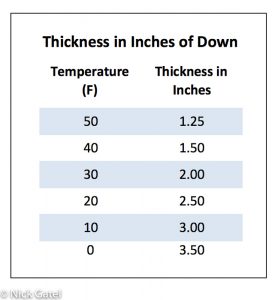
Over the past 50+ years the data from the Natick Laboratory has served me well, with some conditional explanations needed.
Everyone is Different!
Generally women sleep colder than men. Men differ in how much insulation keeps them warm. So, the bottom line is every person will have to experiment to figure out how much insulation they need. Sorry, but that is how it is.
I sleep cold. So I won’t be warm with 2.5 inches of insulation at 20° F. Part of this is due to my living in a hot desert for almost 50 years. The other is I am skinny. The other is my metabolism, which I don’t have much control over. There are other physiological factors, which I have no expertise to even understand. But the fact is, I sleep cold.
Why Would I Buy a Second 20° F Sleeping Bag?
As mentioned earlier, I own a Western Mountaineering UltraLite 20° F sleeping bag. Yet, in 2012 I bought a Zpack 20° F bag? Because I knew it wouldn’t work for me at 20° F.
Another contradiction is, even though I sleep cold, the WM 20° F UltraLite keeps me warm at 20° F.
In 2012, when I bought the Zpack bag, I already had the WM UltraLite and a couple of quilts. My Nunatak Arc Specialist quilt was rated at 32° F, with around 1.75” to 2.0” of insulation. The quilt, which doesn’t fully wrap around the body, has straps to keep the sides of the quilt in place. I’m a side sleeper and this creates drafts at night as I switch which side I am sleeping on. This turning creates drafts. It really didn’t keep me warm at temperatures much below 40° and I would have to wear extra clothing to sleep in. So I needed something in between the Nunatak quilt and the WM UltraLite.
What I wanted, and what ended up working as planned was:
- WM UltraLite for 20° F to about 32° F
- Zpack sleeping bag for 32° F to about 50° F
- Nunatak quilt for anything above 50° F
Extra clothing can be worn at night for extra insulation. My method is to take a sleeping bag/quilt for the expected low. If the weatherman underestimated the coldest temperature, then I can wear extra clothing. What I don’t want to do, and I have done this with failure, is to take a combination of clothes and sleeping bag/quilt to match the expected lows. When the temperature goes below this expected low, this method means a poor night’s sleep.
To understand all of these contradictions, we need to compare the Western Mountaineering bag to the Zpack bag, since they are both “rated” at 20° F.
Zpack versus Western Mountaineering
I removed both sleeping bags from their storage bags and fluffed them up, and ensured the down was equally distributed in all the baffles. Then I laid each out on a flat surface for 24 hours. After this period, I fluffed them up again and did some measurements.
Western Mountaineering UltraLite 20° F
WM markets this as 5 inch thick sleeping bag. They are combining the top and the bottom thickness, which provides 2.5 inches of insulation surrounding the body. Due to its construction the down can be shifted around, just like my Zpack sleeping bag, as they both have horizontal baffles. (Note: the Zpack has changed their construction in the newer model to vertical baffles with a few horizontal baffles at the foot box).
WM Insulation Thickness
WM may market it at 5 inches, but in their specifications they show 5.5 inches, or 2.75 inches surrounding the body. See below:
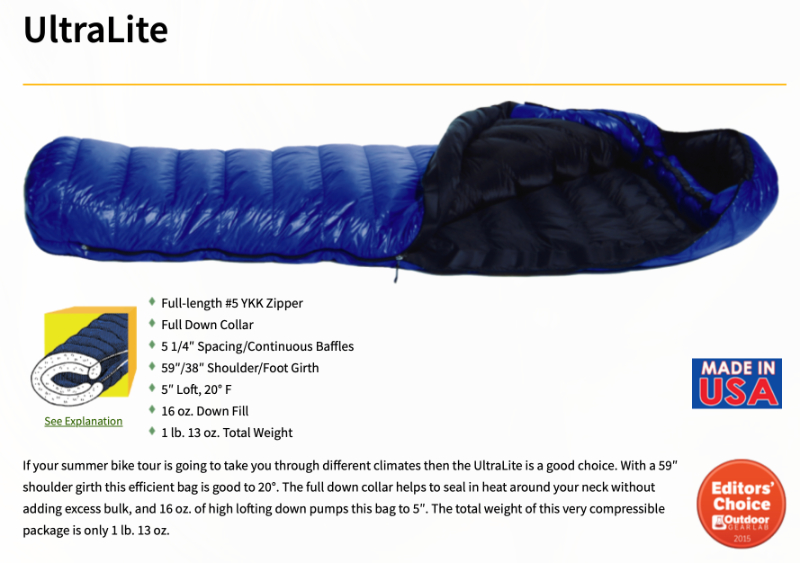
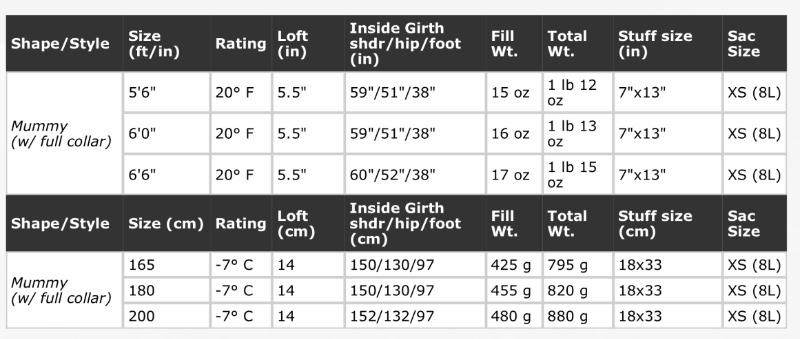
Western Mountaineering UltraLite SpecificationsMy UltraLite sleeping bag is Size 6’0” and shows 16 oz. of down with a loft of 5.5 inches. Measured, the loft is actually 5.75” or 2.875 inches surrounding the body.
If we look at the Natick Laboratory chart for a 20° F sleeping bag, the recommendation is 2.5 inches of insulation. The WM at 2.875 is 15% thicker.
WM Construction
This is a mummy bag. It includes an insulated hood and a draft collar around the neck to seal heat inside. For a side sleeper like me it is somewhat constraining, but it keeps the heat in.
It also has a side zipper to make it easy to get in the bag. To keep heat from escaping from around the zipper, the bag has a draft tube behind the zipper.
Zpack 20° F Classic Sleeping Bag
Zpack’s markets this as 2.5 inch thick sleeping bag. If we combine the top and bottom, like WM does, it would be 5 inches. Due to its construction the down can be shifted around, just like my WM UltraLite (note: Zpack has changed their construction in the newer model).
So the specification of 2.5 inches exactly matches the Natick Laboratory data.
Zpack Insulation Thickness
Zpack may market it as 2.5 inches, but what is it really? For one thing, Zpack specifies in their marketing piece that the target thickness is 2.5 inches . . .
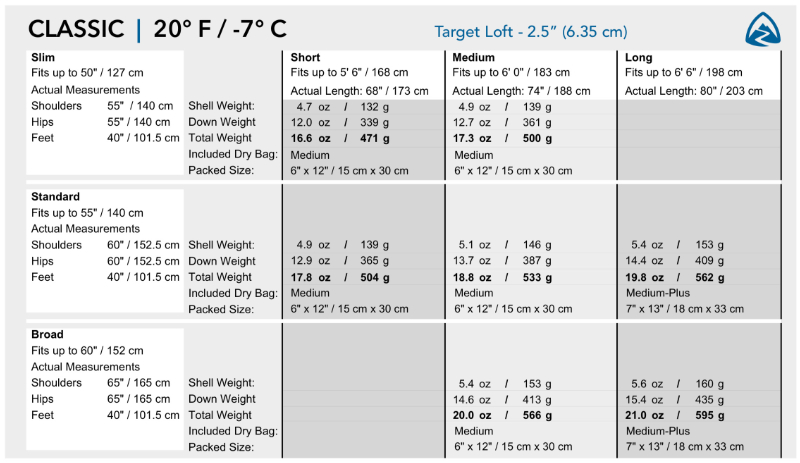
Mine is a little under 2.5 inches averaging around 2.375 inches, or 5% under. For me this is okay because it will never keep me warm at 20° F anyway. This isn’t a complaint. It is because of the sleeping bag’s minimalist design.
WM Construction
This is classic sleeping bag design, not a mummy bag. There is no hood, nor is there a draft collar. The zipper is on the bottom of the bag, so it doesn’t need a zipper draft tube.
Keeping your head warm is extremely important in cold weather. We lose most of our heat through our heads, and our body is designed to protect the brain first and foremost. At 20° F you cannot be warm without some sort of insulation cover the head.
Zpack recommends you buy their $70 goose down hood with the sleeping bag. The thought being that a separate hood can be used to keep warm in camp or during the day. The separate hood becomes a multi-use gear item and it is in keeping with “ultralight backpacking principles.”
Other Comparisons
Measurements and Weights
I built this table to summarize some important data:

The Zpack bag has 13.7 ounces of down versus 16 ounces for the UltraLite. But WM needs extra down for the hood, draft collar and draft tube. More important than the weight of the down are the measurements.
The Zpack bag has wider shoulder, hip and foot girths, meaning there is more volume to fill in the main bag than the WM UltraLite.
Overall, the WM weighs 10.2 ounces more than the Zpack sleeping bag. Much of this is due to the Western Mountaineering hood, draft collar and draft tube, plus more robust components.
Insulation Thickness
I made a simple measurement rig using a straight edge and 5.75” of blocks on each side. The differences are visually apparent.
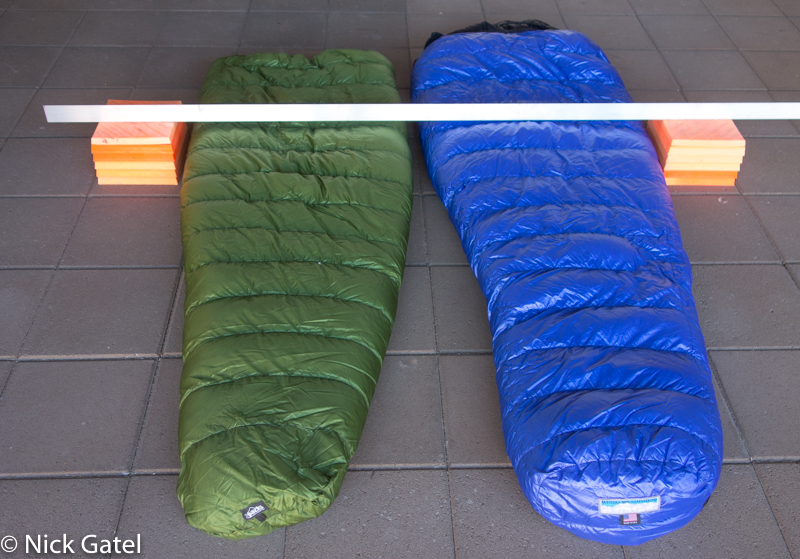
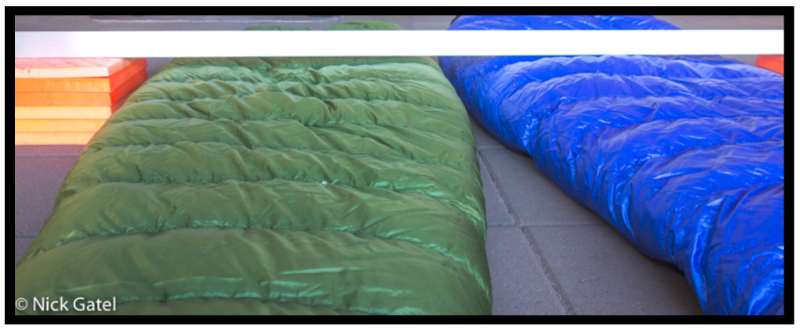

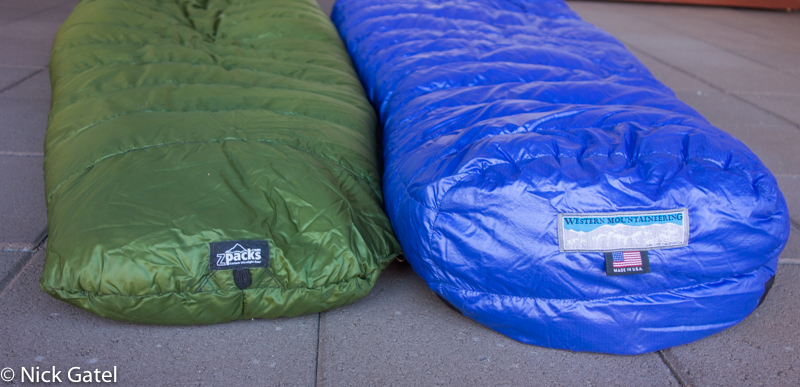
Construction & Design
Zpack Zipper
The zipper is located on the bottom of the sleeping bag. This eliminates the need for a draft tube, and more important for me, makes it easy to open the sleeping bag into a quilt configuration in warmer temperatures.
I really like this feature and was one of the selling points for me. For others it might be problem since you have to slide into the bag pulling up like a giant potato sack.
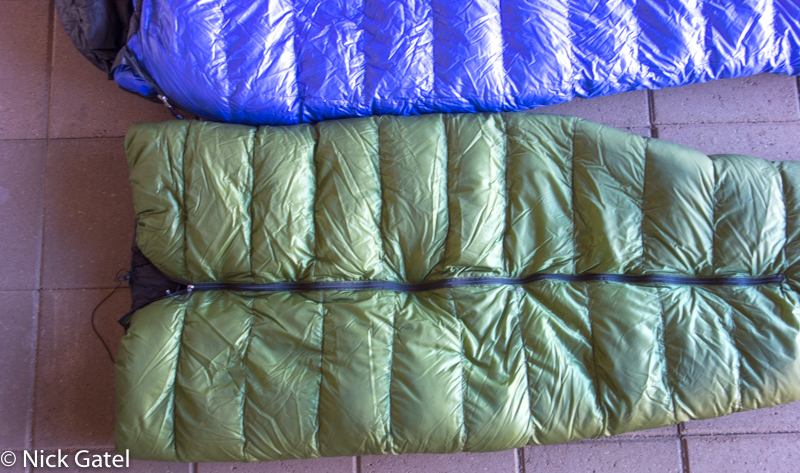
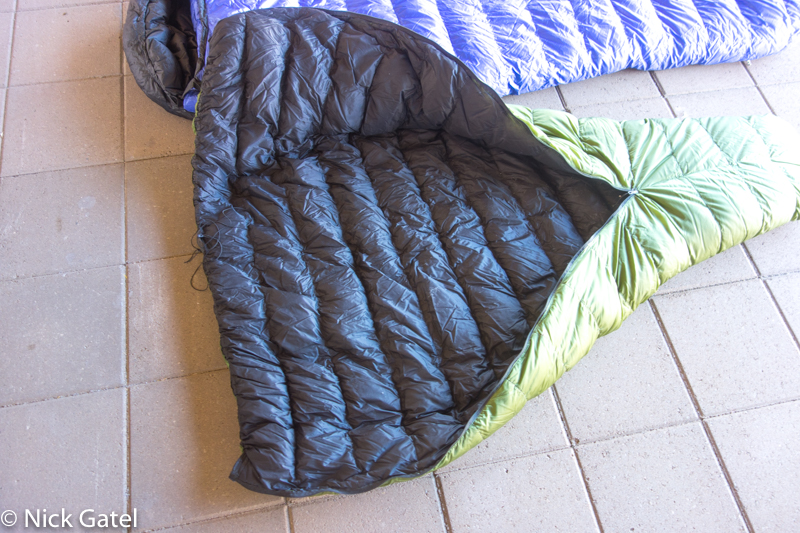
Some Quality Differences
Zippers
Western Mountaineering uses a #5 YKK zipper versus the lighter, smaller and more fragile #3 YKK Zpack zipper.

Sewing
Take a close look at these stitches I took pictures of at random. The WM is far superior and clean. However, I haven’t had any problems with the Zpack stitching.
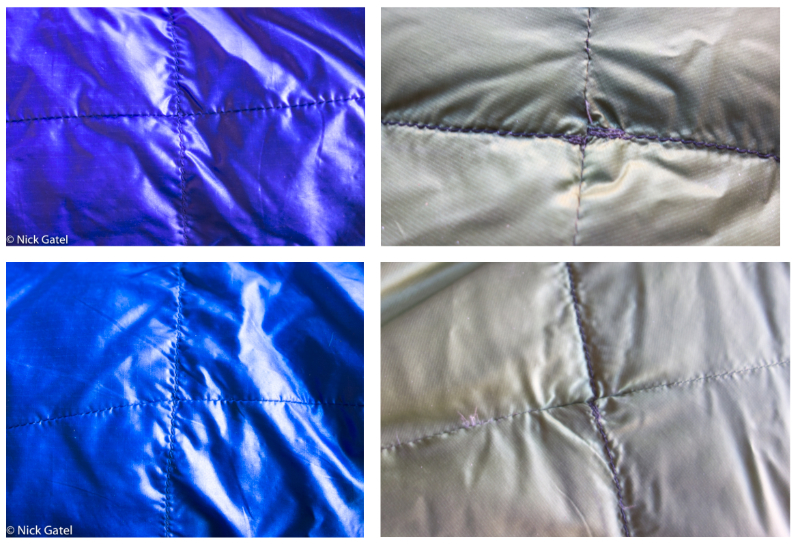
Draw Cords
The WM cord is just like new. It is thick and strong. The Zpack cord is thin and made from an elastic cord that has stretched and lost all of its elasticity. I’ll need to replace it soon.

Warranty
Both bags are made in the USA..


Price Differential
The Western Mountaineering costs around $90 more than the Zpack. Whether saving 10 ounces on the Zpack is worth saving the money is a personal decision for each person.
This doesn’t take into consideration the differences in quality, function, and probably durability.
Western Mountaineer sleeping bags are only sold through its dealer network and rarely on sale. Here is the best price I found today at Campmor.
As far as I know, the Zpack sleeping bag can only be purchased directly from Zpack.
Summary
This is from my 2012 receipt:

In fourteen years the price has gone up about $100.
I have been very happy with my Zpack sleeping bag. It fits nicely in my selection of sleeping and quilt, between my warmest bag and my lighter quilt. With the three I have lots of options depending on the weather.
If I had to do everything over, I would make the same purchase decisions. With the Zpack bag I often have to wear some sort of hat or baclava to stay warm though, and for me it is definitely not even close to being a 20° F sleeping bag.
Here are some pictures of the Zpack sleeping bag in action. Click on an image and then scroll through the pictures.
